Salty Source
The Source of the River Sals
I have always been interested in geology and thought I would like to see the source of the River Sals near Sougraigne. When my friend Dave the Intrepid offered a trip to Rennes-les-Bains, I asked him to drive across the mountains on the way to find the source of the river in which, it is thought, Mary Magdalene baptised people at Rennes-les-Bains.
The village of Sougraigne consists only of a handful of houses and an 18th century church with a cross outside dated 1880 to commemorate a rare visit from the bishop, even though Sougraine was owned by the Abbey of St. Polycarp.
To find the source, take the D74 from Rennes-les-Bains to Sougraigne, pass Sougraine, then 2.5km further on look out for a sign on the side of the road. Turn right.
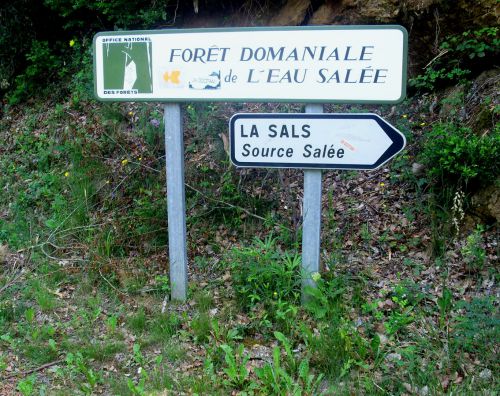
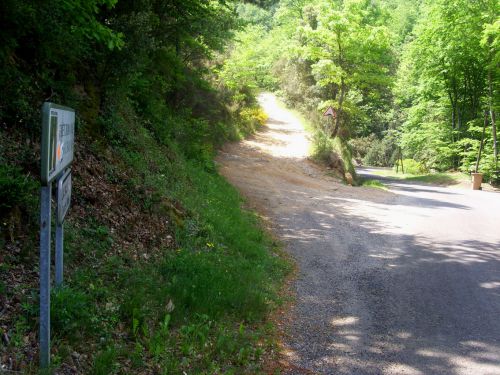
The road was a track and we thought it better not to risk the car - who know what we would find up ahead? 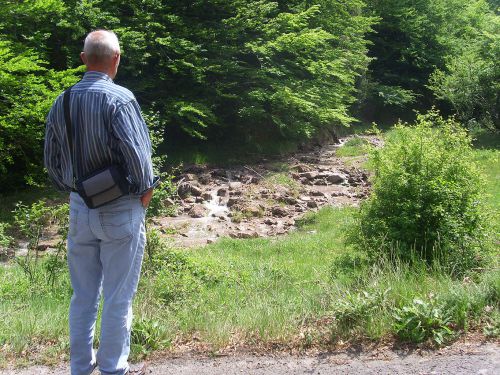
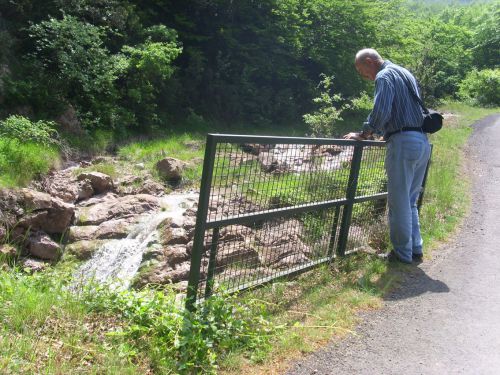
However, it was tarmaced later, but in true explorer manner, we continued undaunted. It must have been approaching a kilometre in wonderful forests with the river Sals cascading down beside us. Eventually we saw a building in the distance and thought we were there, but no! There was a car-park and a signed footpath climbing even higher!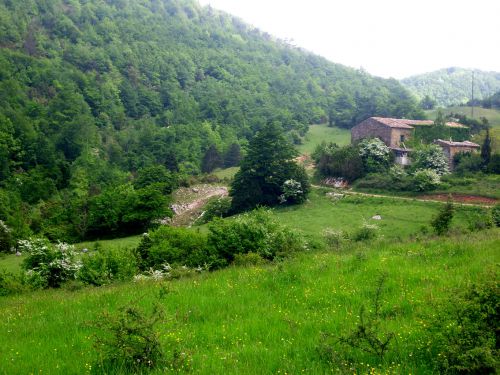
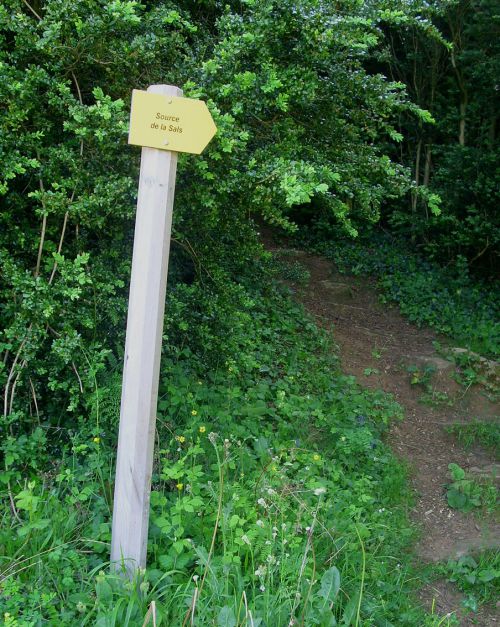
In the carpark were notices giving us information about the region and the Source Salee - salty source. One said; The salty Source called L aiga Salada in Occitan; Situated in the commune of Sougraigne, the salinity varies according to the seasons and the rainfall. It is the birth of the river Sals which throws itself into the Aude at Couiza. Rainwater infiltrates the limestone and loads itself with salt while crossing an important deposit of crystal salt. (At times, the Sals has 60 grams per litre of salt - twice that of the Mediterranean. The sea generally has 3 parts per 100 of salt - 30 gms per litre. A book about life at Sougraine around 1910 tells us the river held 30 grams of salt per litre.)
In the 15th century, a salt tax was created, called Gabelle. The local country people were authorised to use the salt for their own purposes, but they rapidly began to evaporate the water and sell the salt. As time went on, a small group of soldiers were installed at the place now called Les Gabelous or Garde des Corps to prevent this practice. This salt tax, throughout France, was considered extortionate, and resentment against the tax was one of the causes of the Revolution. The aristocracy of that time also became rich from the salt-pans of the Mediterranean, near Peyriac-de-Mer, Gruissan and Sigean. (These salins - a word of Roman origin - are lagoons in which the sea-water is left all summer, until the sun and the wind dry it out. People come along with jars to collect it, and use it domestically and say it tastes better than salt they buy.)
The path upwards through the forest was a steep climb - wear proper shoes! - but beautiful. Hikers, geologists would like it; in the month of May it is a paradise for botanists, full of colour. We passed a sign to Bugarach, 2km away. The Sals originates underneath Bugarach, which was once a volcano. On the way was a mysterious stone. What does the inscription say? 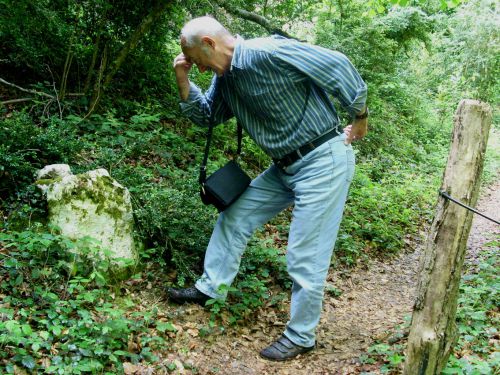
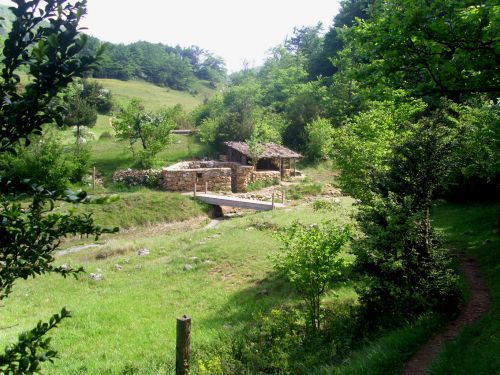
Then we emerged into a clearing and to the right was the source. It is amazing. One cannot see any crack or crevice; it appears to bubble up spontaneously from the ground.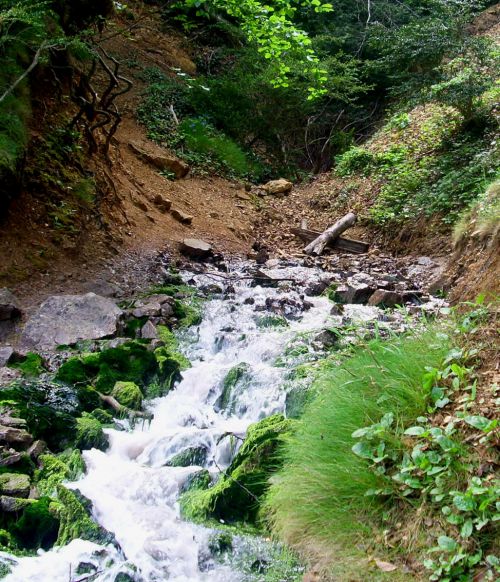
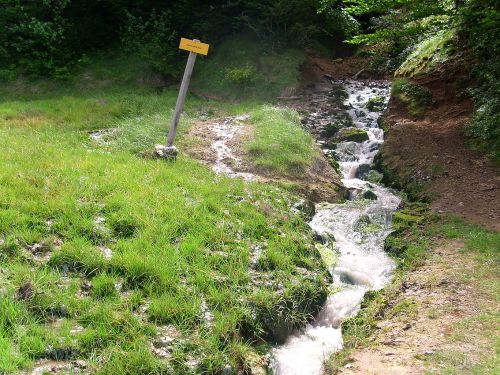
To the left of it are other streams in the grass; a minor source that soon joins the other.
Across the field were two reconstructed huts where the peasants lived while they evaporated the water off in huge saucepans. 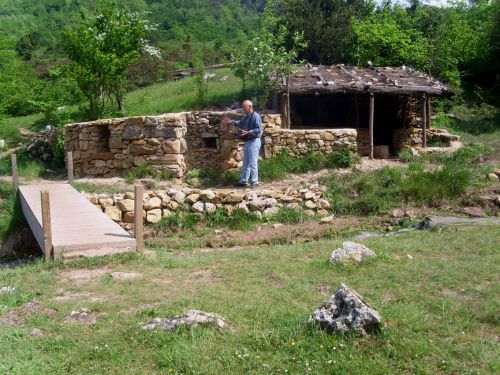
I found out later that this method was used in Roman times, which implies the Romans knew of the salty source of the Sals. The Romans thought salt so valuable they even paid their soldiers with it - hence the word salary from sal the Latin for salt. Latin is the basis of the Occitan language and they have many words based on sal - salad is one of them.
In early times, said my encyclopedia, salt was often made from brine found in natural wells or springs, formed by water soaking through rock-salt deposits. The Romans found tribes throwing the brine on their fires, and scraping off the crystals that formed. Less primitive tribes made a cleaner product by heating large stones and throwing the brine onto them. The Romans improved on these processes by evaporating the brine in shallow lead pans, heated by wood fires. Further research found that the ancients Celts were refining salt since 600BC. The Celts - Volques-Tectosages - lived in this region of region before the Romans came in 70BC, and then intermarried with them to make the Gallo-Roman people, the ancestors of many Languedocians today.
The salty source of the Sals near Sougraine has been known since antiquity.
Inside one hut was a notice that said; An earthquake in 1825 was responsible for an increase in the salt content of the water. It became more profitable therefore, to evaporate it and the owners of Les Gabelles, which owned the land, did not hesitate to charge the peasants rent (25% of the salt they found) for living in the huts they had erected themselves. At one time there were 22 of these huts by 1839, and you can still see the remains in the grass of others. Whatever disputes this caused we don't know. Salt was a very valuable commodity at the time, in a peasant society used to growing and making things themselves. But by 1842 more guards were employed and the salt-collecting, and the huts, gradually fell into disuse.
I liked this place, it had a real atmosphere, a mountain pasture very high up (the temperature was 3 degrees lower than where we had parked the car) and you could see right down the valley, even as far as Rennes-le-Chateau, perched on its hill like a white coronet with the Pyrenees beyond.
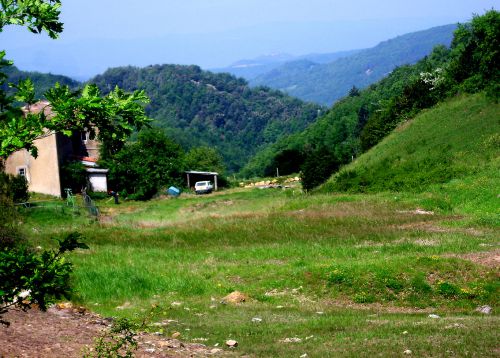
I wondered how salty the water would have been in 33AD when Mary Magdalene came to the region. She baptised in the River Sals at the Fontaine des Armours and le Benitier. Was salty water considered clean or unclean by the Jews? Of course, at the time the water might not have been salty at all - who knows what minor earthquakes upset the inner workings of the ancient volcano Bugarach during 2,000 years?
However, Dave thought that if the water was salty when Mary M baptised, that would have been considered a benefit. The Ancient Jews and the Romans used salt in their sacrifices and thus discovered that salt preserved meat. It was therefore considered clean, even a disinfectant, certainly an almost God-given boon for mankind, especially as people living in hot countries need more salt. As something of value, salt was offered to guests in the house in Middle Eastern countries, and I even experienced this myself in Yugoslavia. Guests were traditionally offered salt, raw onion and a chunk of bread as a welcome. It made a good aperitif!
It is obvious that the Romans named the River - Sals. So yes, it was salty in Roman times, earthquakes or not, although we do not know how much so, and the salt would have added to the holiness of the place now called Rennes-les-Bains.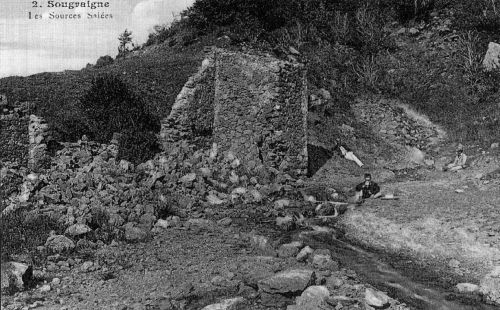
the source as it was in 1910
And lastly, I made a little film on a recent visit in July 2013. It gives the atmosphere in the place even though a thunderstorm was due - we made it back to the car just in time! Click here to see it.
Inscrivez-vous au blog
Soyez prévenu par email des prochaines mises à jour
Rejoignez les 97 autres membres


